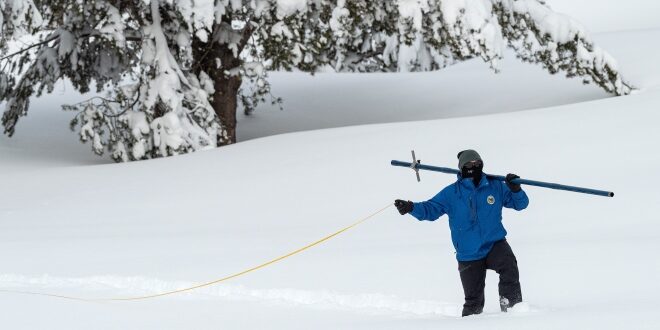Yesterday the Department of Water Resources (DWR) conducted its first snow survey of the season at Phillips Station. The manual survey recorded a depth of 78.5 inches and a snow water equivalent of 20 inches.
That’s 202 percent of average for this location at this time of year.
Californians should be rejoicing. The drought is over, right? Well, not so fast. While December’s storms have dumped feet of snow onto the Sierras, we still have a long way to go. And, we’ve seen this scenario before – a wet December followed by a long dry spell that ended with the state’s driest year on record.
“We could not have asked for a better December in terms of Sierra snow and rain,” said DWR Director Karla Nemeth. “But Californians need to be aware that even these big storms may not refill our major reservoirs during the next few months. We need more storms and average temperatures this winter and spring, and we can’t be sure it’s coming. So, it’s important that we continue to do our part to keep conserving – we will need that water this summer.”
December is the first of the three typically wettest months of California’s water year. Significant January and February precipitation would be required to generate enough runoff to make up for the previous two winters that were California’s fifth- and second-driest water years on record.
Forecasts are saying California will wrap up 2021 with yet more mountain snow and valley rain through New Year’s Eve. However, long-range forecasts are looking a bit drier.
“The snowfall we’ve seen across the state over the past few weeks is certainly a welcome sight,” said Adel Hagekhalil, general manager of the Metropolitan Water District of Southern California. “But regardless of the precipitation we see in the near term, we need to continue our efforts to build sustainable water supplies that make us more resilient to drought and the changing climate. This requires us to invest in conservation, recycling and storage to take advantage of big water years when they come. This snowfall is good news but doesn’t change our need to prepare and continue to be vigilant about our water use and investments for the future.”
DWR also reported that the overall Statewide snowpack is 160 percent of average for this date.
DWR conducts five media-oriented snow surveys at Phillips Station each winter near the first of each month from January through April and, if necessary, May.
 California Water News Daily Your Source For Water News in California
California Water News Daily Your Source For Water News in California


